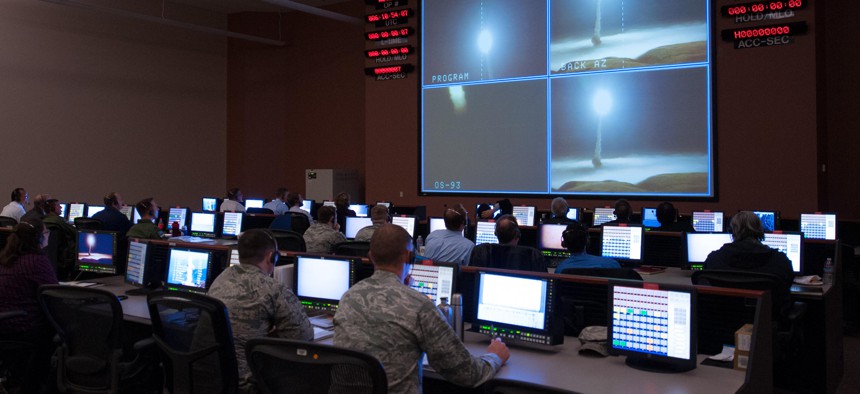
Members of the 576th Flight Test Squadron oversee the launch of an unarmed Minuteman III missile March 27, 2015 at Vandenberg Air Force Base during an operational test launch. Michael Peterson / Air Force
Creating Space Force Will Cost $13B Over 5 Years: USAF Secretary
In a pointed memo, Heather Wilson counters several Space Force proposals championed by Deputy Defense Secretary Patrick Shanahan.
Standing up the Pentagon’s new Space Force will cost nearly $13 billion over five years, according to U.S. Air Force estimates, Defense One has learned.
That estimate is included in a Sept. 14 memo from Air Force Secretary Heather Wilson to Deputy Defense Secretary Patrick Shanahan. In the 16-page memo, Wilson lays out her own plan for standing up the new branch of the U.S. military championed by President Trump. She also pushes back on various aspects of Shanahan’s Space Force plan.
In particular, Wilson argues against the proposal to create a Space Development Agency to oversee satellite acquisition and to establish a new top-level position in the Office of the Secretary of Defense.
“[T]here is no need to establish an Assistant Secretary of Defense for Space, nor is there any benefit to either establishing an additive agency or moving programs to a temporary holding organization,” she wrote.
Wilson — who in the past objected to removing military space activities from the Air Force — argues that her plan “establishes a clear mission, directly related to the strategic problem we’re trying to solve.”
The memo also says the Air Force estimates that creating Space Force will cost more than $3 billion in its first year and an additional $10 billion over the four following years. The Air Force estimates the Space Force would total about 13,000 people.
Defense One reviewed a copy of the memo, which Wilson alluded to in a speech given Monday at the Air Force Association’s annual Air Space and Cyber Conference in National Harbor, Maryland.
In her State of the Air Force address, Wilson said the Air Force — which oversees the lion’s share of military space activities — must play a role in the creation of a Space Force. Defense sources have said that the Air Force was largely cut out of a Pentagon effort that started the process of standing up the Space Force.
“As airmen, we have a responsibility to develop a proposal for the president that is bold and that carries out his vision,” Wilson said on Monday.
Earlier this year, Shanahan laid out the Pentagon’s initial plans to change the way it oversees space, saying the Defense Department would stand up U.S. Space Command, a combatant command that would oversee warfighting in space, and a Space Development Agency for buying satellites.
In her memo to Shanahan, Wilson calls for the Air Force Space Rapid Capabilities Office to become the Space Development Agency, a new satellite buying organization championed by Shanahan.
“This office exists now and has the personnel and expertise to develop and field the warfighting capabilities needed by U.S. Space Command,” Wilson writes.
The Pentagon’s fiscal 2020 budget proposal, which is expected to head to Congress in February, is expected to include legislation calling for the creation of a Space Force, according to defense officials. If Congress approves the Space Force, Wilson, in her memo, writes that Air Force space personnel and projects could be transferred to the new service in fiscal 2021.
Wilson said the Space Force must have deeper ties with intelligence community.
“That proposal must contain all of the elements needed for space to be fully successful as a department,” she said. “It must maintain a close connection between acquisition and the warfighter and it must deepen the already close connection between military space and the space elements of the intelligence community.”
Combining the National Reconnaissance Office into a Space Force was not part of a Pentagon plan to start reorganizing its space forces in advance of the creation of a new branch of the military that President Trump desires.
Wilson, in her memo to Shanahan, calls for the head of the National Reconnaissance Office to also be the head of the Air Force Space Rapid Capabilities Office, “establishing a unity of command for these organizations.”
Wilson, in her speech, said the Air Force will continue its restructuring of its Los Angeles-based Space and Missiles Systems Center, the organization that oversees most of the Air Force’s satellite buys and launches.
“The Air Force proposal accomplishes several things: it focuses Department attention on what problems need to be solved; maximizes the utilization of existing resources; avoids the creation of duplicative functions; and provides a path to accomplishing the President’s vision for a separate Department of the Space Force,” Wilson writes in the memo. “The approach avoids disrupting programs and increasing risk to ongoing effort, while providing a vision for a comprehensive space force.”







